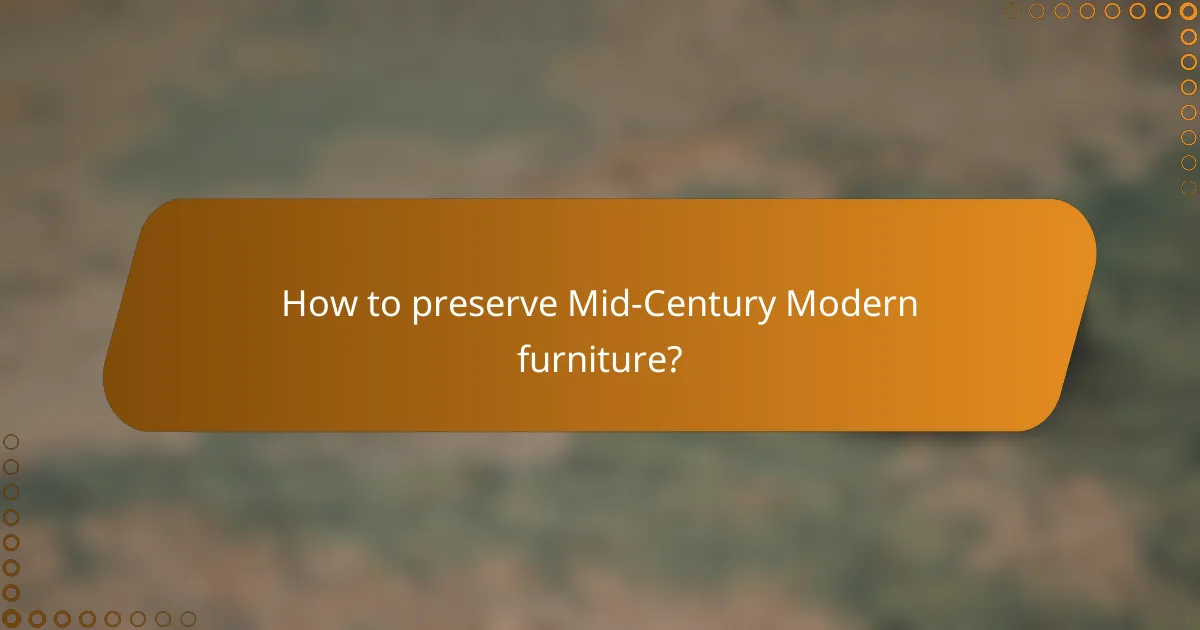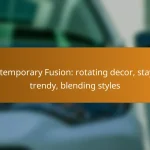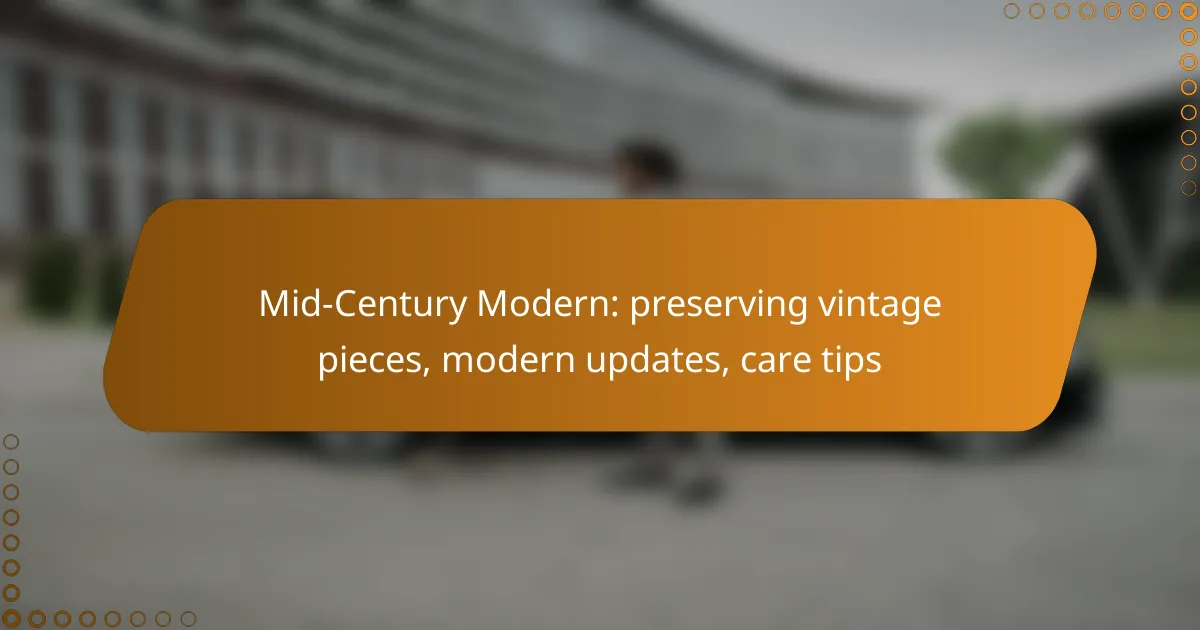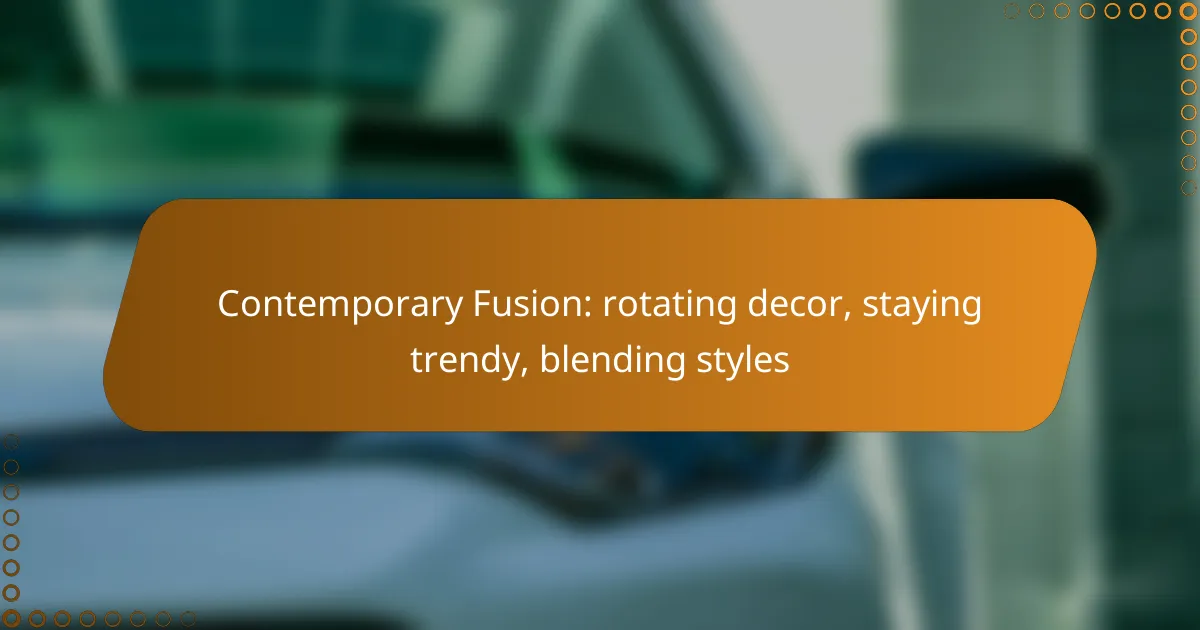Mid-Century Modern furniture embodies a unique blend of timeless design and functionality, making it essential to preserve these vintage pieces with proper care. By employing specific cleaning, storage, and maintenance techniques, you can maintain their aesthetic and structural integrity. Additionally, modern updates can enhance these items, allowing for a seamless integration of contemporary elements while respecting their classic charm.

How to preserve Mid-Century Modern furniture?
To preserve Mid-Century Modern furniture, focus on proper cleaning, storage, and maintenance techniques. These vintage pieces require specific care to maintain their aesthetic and structural integrity over time.
Use proper cleaning techniques
Cleaning Mid-Century Modern furniture requires gentle methods to avoid damaging finishes. Use a soft, lint-free cloth and mild soap mixed with water for routine cleaning. Avoid harsh chemicals that can strip finishes or discolor wood.
For upholstered pieces, vacuum regularly to remove dust and debris. Spot clean stains with appropriate fabric cleaners, testing in an inconspicuous area first to ensure colorfastness.
Store in climate-controlled environments
Storing Mid-Century Modern furniture in a climate-controlled environment helps prevent damage from humidity and temperature fluctuations. Aim for a stable temperature range of around 20-22°C (68-72°F) and humidity levels between 40-60%.
When storing, use breathable covers to protect against dust while allowing airflow. Avoid basements or attics where conditions can vary significantly and lead to warping or mold growth.
Avoid direct sunlight exposure
Direct sunlight can fade and damage the finishes of Mid-Century Modern furniture. Position pieces away from windows or use UV-filtering window treatments to minimize exposure.
If moving furniture is not feasible, consider using protective furniture pads or covers during peak sunlight hours to shield them from harmful rays.
Utilize protective coatings
Applying protective coatings can help preserve the finish and enhance the durability of Mid-Century Modern furniture. Use a high-quality furniture polish or wax designed for wood surfaces to create a barrier against moisture and dirt.
Reapply these coatings every few months, depending on usage, to maintain the protective layer and keep the furniture looking its best.
Regularly inspect for damage
Regular inspections are crucial for identifying and addressing damage early. Check for scratches, dents, or loose joints at least once a season to ensure the furniture remains in good condition.
If you notice any issues, address them promptly. Minor scratches can often be repaired with wood filler, while loose joints may require tightening or professional assistance to prevent further damage.

What modern updates can enhance Mid-Century Modern pieces?
Modern updates can significantly enhance Mid-Century Modern pieces by blending their timeless design with contemporary elements. This approach maintains the vintage aesthetic while improving functionality and comfort.
Incorporate contemporary upholstery
Updating upholstery with contemporary fabrics can breathe new life into Mid-Century Modern furniture. Opt for materials that are durable and easy to clean, such as performance fabrics or natural fibers like linen and cotton. Choose bold colors or patterns that complement the original design while adding a fresh touch.
When reupholstering, consider the original shape and structure of the piece to maintain its integrity. Avoid overly ornate patterns that clash with the clean lines typical of this style.
Add modern lighting fixtures
Modern lighting fixtures can enhance the ambiance of a Mid-Century Modern space while providing necessary illumination. Look for sleek designs in materials like metal or glass that echo the minimalist aesthetic. Pendant lights, floor lamps, and wall sconces with geometric shapes can create a striking contrast with vintage furniture.
Consider energy-efficient LED bulbs to reduce electricity costs while maintaining a warm glow. This not only modernizes the space but also aligns with sustainable practices.
Use minimalist decor
Minimalist decor complements Mid-Century Modern pieces by emphasizing their clean lines and functional forms. Choose a few statement pieces rather than overcrowding the space with accessories. Items like a single large artwork or a sculptural vase can draw attention without overwhelming the room.
Incorporate natural elements, such as plants or wooden accents, to add warmth while keeping the decor simple. This approach enhances the overall aesthetic without detracting from the vintage furniture.
Integrate smart home technology
Integrating smart home technology can modernize Mid-Century Modern spaces while enhancing convenience. Consider smart thermostats, lighting systems, or speakers that blend seamlessly with the decor. Devices that are compact and unobtrusive will maintain the aesthetic integrity of the space.
Ensure that any visible technology complements the design of your furniture. For example, choose smart devices in neutral colors or sleek designs that align with the Mid-Century Modern style.

What are the best care tips for vintage Mid-Century Modern items?
To preserve vintage Mid-Century Modern items, focus on specific care techniques tailored to their materials and design. Regular maintenance, appropriate cleaning methods, and prompt repairs can significantly extend the life of these cherished pieces.
Follow specific material care guidelines
Each material used in Mid-Century Modern furniture requires unique care. For instance, wood pieces benefit from a gentle approach, avoiding harsh chemicals that can strip finishes. Metal surfaces may need occasional polishing to prevent rust, while upholstery should be treated according to its fabric type.
Refer to manufacturer guidelines or reputable resources for detailed care instructions specific to your items. This ensures you are using the right techniques to maintain their integrity and appearance.
Regularly polish wood surfaces
Wood surfaces in vintage Mid-Century Modern furniture should be polished regularly to maintain their luster and protect the finish. Use a high-quality furniture polish or a mixture of olive oil and vinegar to nourish the wood without damaging it.
A good rule of thumb is to polish every few months, or more frequently if the furniture is in a high-traffic area. Avoid using silicone-based products, as they can create a buildup that dulls the finish over time.
Use appropriate cleaning products
When cleaning vintage Mid-Century Modern items, select products that are safe for the specific materials. For wood, a mild soap solution or specialized wood cleaner is ideal, while glass surfaces can be cleaned with a standard glass cleaner.
Always test a small, inconspicuous area first to ensure there are no adverse reactions. Avoid abrasive cleaners that can scratch or damage surfaces, and opt for soft cloths to prevent wear.
Repair minor damages promptly
Addressing minor damages like scratches or dents quickly can prevent further deterioration of vintage Mid-Century Modern items. Use wood fillers for small scratches and touch-up pens for minor nicks in the finish.
For upholstery, consider using fabric glue or patch kits to mend small tears. Timely repairs help maintain the aesthetic and value of your pieces, ensuring they remain in good condition for years to come.

What are the key characteristics of Mid-Century Modern design?
Mid-Century Modern design is characterized by clean lines, organic forms, and a focus on functionality. This style emerged in the mid-20th century and emphasizes simplicity and integration with nature.
Sleek lines and organic shapes
Sleek lines and organic shapes define the aesthetic of Mid-Century Modern design. Furniture often features smooth, flowing curves and minimal ornamentation, creating a sense of harmony and balance. Pieces like the Eames Lounge Chair exemplify this principle with their elegant contours.
When selecting furniture, look for items that highlight these characteristics. Avoid overly ornate designs and opt for pieces that showcase simplicity and grace.
Use of natural materials
Natural materials play a crucial role in Mid-Century Modern design, with wood, leather, and stone being common choices. These materials not only enhance the aesthetic but also promote a connection to the environment. Teak and walnut are particularly favored for their durability and beauty.
To maintain authenticity, choose vintage pieces or modern reproductions that utilize these materials. Be cautious of synthetic alternatives that may detract from the original charm.
Functional and aesthetic balance
Mid-Century Modern design achieves a balance between functionality and aesthetics, ensuring that each piece serves a purpose while remaining visually appealing. This approach encourages the use of multi-functional furniture, such as a coffee table that doubles as storage.
When decorating, prioritize pieces that combine utility with style. Avoid clutter by selecting items that fulfill multiple roles, enhancing both the look and practicality of your space.

How to identify authentic Mid-Century Modern pieces?
Identifying authentic Mid-Century Modern pieces involves recognizing key characteristics that distinguish them from reproductions. Look for specific design elements, materials, and historical context to ensure authenticity.
Check for manufacturer labels
Authentic Mid-Century Modern furniture often features manufacturer labels that provide information about the brand and production date. Look for labels from well-known companies such as Knoll, Herman Miller, or Eames, as these can significantly enhance the value of the piece.
Labels may be found on the underside of tables, the back of chairs, or within drawers. If a piece lacks a label, research the design and compare it with known examples to verify its authenticity.
Examine construction techniques
Mid-Century Modern pieces are typically constructed with high-quality materials and craftsmanship. Look for solid wood construction, dovetail joints, and minimal use of particle board or plywood. Authentic pieces often exhibit a level of detail and finish that reflects the era’s emphasis on quality.
Pay attention to the joinery and overall sturdiness. If the piece feels flimsy or has visible signs of cheap construction, it may not be an authentic Mid-Century Modern item.
Research design history
Understanding the design history of Mid-Century Modern furniture can help you identify authentic pieces. Familiarize yourself with key designers, styles, and trends from the 1940s to the 1960s. This knowledge will enable you to spot distinguishing features and common motifs associated with the movement.
Utilize resources such as design books, online databases, and museum collections to deepen your understanding. Engaging with communities or forums dedicated to Mid-Century Modern design can also provide valuable insights and tips for identifying genuine pieces.










